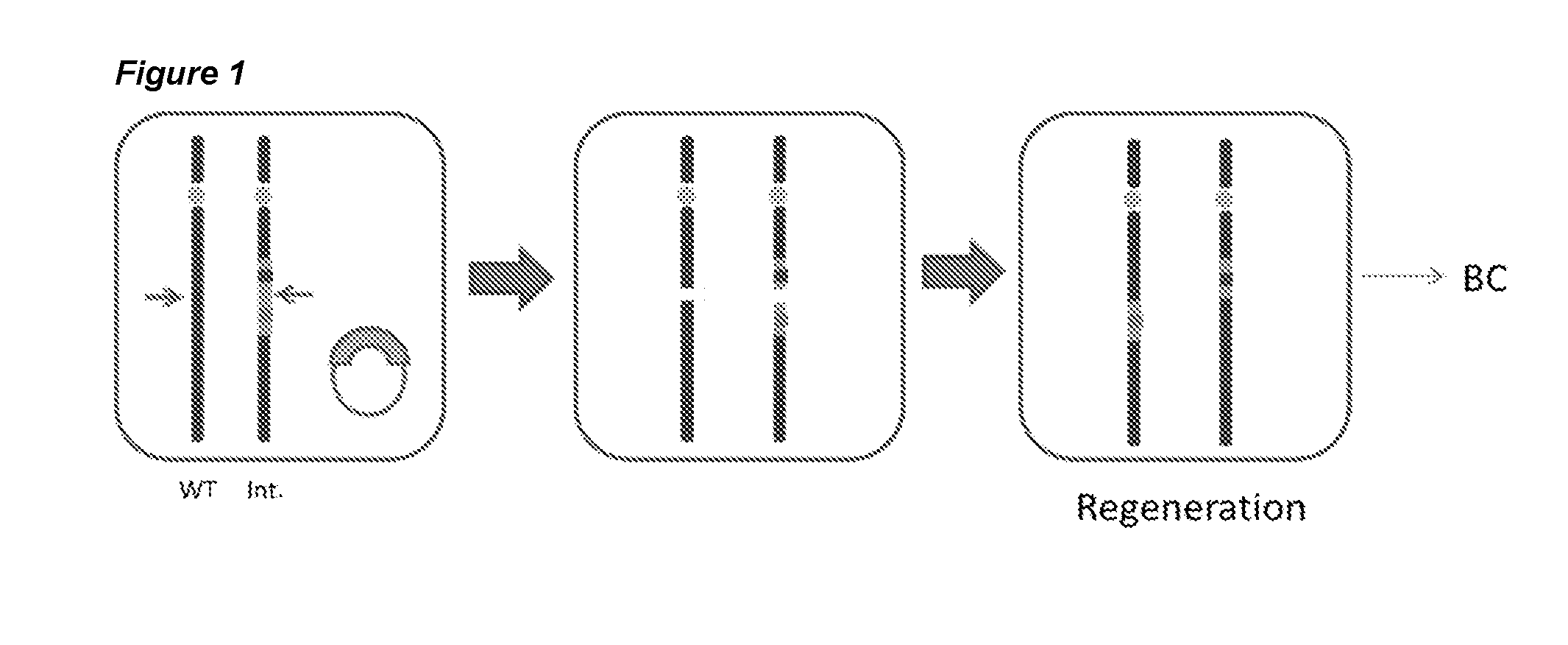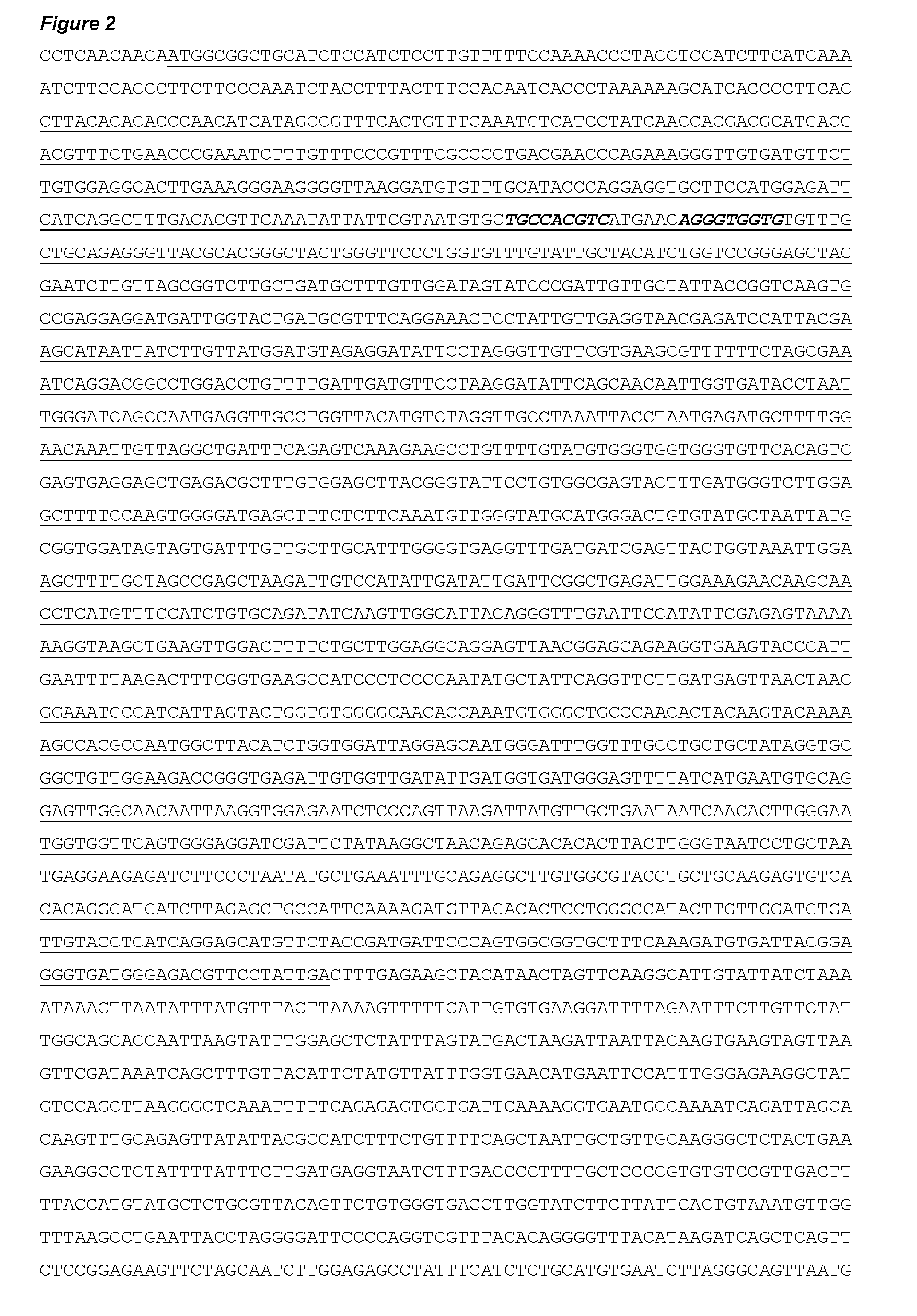Method for removing genetic linkage in a plant
a technology for removing genetic linkage and plants, applied in the field of plants, can solve the problems of fidelity of process, bottlenecks in the breeding process, inability to obtain plants with only the desired genes and associated traits, etc., and achieve the effect of removing linkage drag
- Summary
- Abstract
- Description
- Claims
- Application Information
AI Technical Summary
Benefits of technology
Problems solved by technology
Method used
Image
Examples
example 1
Inducing a Targeted Translocation at Chromosome VII in Tomato Protoplasts
[0102]The experimental setup for generating targeted translocations in tomato cells is shown in FIG. 1. The approach uses a site specific nuclease, in this example a zinc finger nuclease, which induces a DNA double strand break (DSB) at the same or corresponding genomic position on both of the homologous chromosomes. A translocation between the chromosomes can then be formed when these two DSB's are repaired by joining the DNA ends together from the other chromosome, thus exchanging the chromosome arms. To detect the formation of translocations, PCR primers were designed that specifically amplify the ZFN cut site on each chromosome. Once a translocation has been formed these junctions can be specifically amplified by using different combinations of these forward and reverse primers. For specific primer design, sequence differences must be present flanking the ZFN cut site on each chromosome. This was achieved b...
example 2
Breaking the Linkage Drag at the TYLCV Locus
[0113]Tomato yellow curl leaf virus (TYLCV) is a devastating tomato disease caused by a begamovirus and transmitted by whitefly. TYLCV infection is common in warm (sub)tropical regions and this limits tomato growth in these regions. Resistance to TYLCV infection has been found in several wild tomato species (Ji et al. (2007) in Tomato Yellow Leaf Curl Virus Disease (Czosnek, H., ed). Netherlands: Springer, pp. 343-362). Currently, five resistance loci are used in breeding, Ty1 to Ty5. The Ty1 locus from S. chilense LA1969 was the first resistance locus to be mapped and is linked to the Ty3 locus on chromosome 6 and has been incorporated into several commercially available varieties. However, the Ty1 resistance locus suffers from linkage drag as it is accompanied by undesirable traits such as autonecrosis. The Ty1 locus is located in the pericentromeric region of chromosome 6 and is located on a 17 MB introgression fragment which suffers fr...
example 3
Creating an Introgression of a Defined Size in Tomato Breeding Material and Fine Mapping of a Gene Responsible for Early Fruit Ripening
[0116]A tomato line, ER43, carrying a locus on chromosome I responsible for early fruit ripening can be identified. Through marker analysis it can be established that the locus is located between the AFLP markers MM101 and MM107, which are separated by 527 kbps. The complete sequence of this region is available and so a series of target sequences can be selected spaced by 100 kbps which, based on BLAST analysis, are single copy sequences in the tomato genome. Primers are designed flanking these target sequences and used to amplify the corresponding loci in the tomato line Moneymaker (available from: http: / / www.seedaholic.com / tomato-cherry-fox-organic-seeds-1.html) to firstly confirm that the target sequences are identical in both lines and secondly to identify sequence differences around these target sequences in the two tomato lines which can be exp...
PUM
| Property | Measurement | Unit |
|---|---|---|
| Length | aaaaa | aaaaa |
| Electrical resistance | aaaaa | aaaaa |
| Size | aaaaa | aaaaa |
Abstract
Description
Claims
Application Information
 Login to View More
Login to View More - R&D
- Intellectual Property
- Life Sciences
- Materials
- Tech Scout
- Unparalleled Data Quality
- Higher Quality Content
- 60% Fewer Hallucinations
Browse by: Latest US Patents, China's latest patents, Technical Efficacy Thesaurus, Application Domain, Technology Topic, Popular Technical Reports.
© 2025 PatSnap. All rights reserved.Legal|Privacy policy|Modern Slavery Act Transparency Statement|Sitemap|About US| Contact US: help@patsnap.com



